Words and Photos: Masonry Cosmetics, Inc.
Techniques used by manufacturers to give the original colors to brick, mortar and manufactured stone can be used to recolor masonry components of an indoor fireplace without removing or replacing the masonry. The result is a new look that is as natural, complex, and permanent as that of the original natural or manufactured materials at a small fraction of the cost of rebuilding.
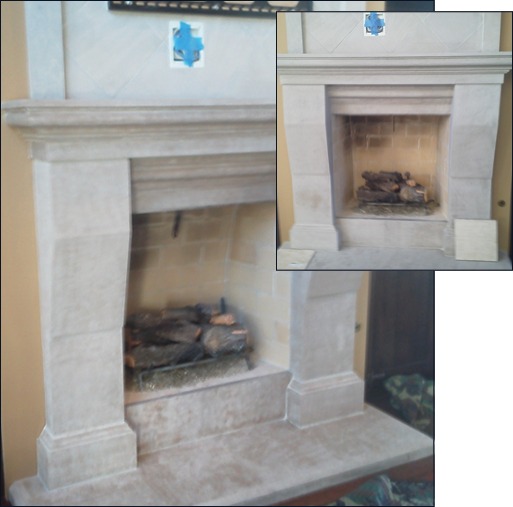
Homeowners have an overwhelming desire to periodically remodel their homes. A new owner often has different tastes than the builder or previous owner. Long-time owners may find that their tastes change with time and the experience of seeing other living spaces. Others may wish to increase the size or arrangement of rooms, and are delighted to take the opportunity to change the decor as well. The home fireplace is a large and eye-catching feature of any room. If the new decor clashes with the appearance of the fireplace, one or the other will have to be changed.
A Dilemma for Homeowners
A masonry fireplace is an important feature of a home that can significantly increase its value, by providing beautiful natural stone or brick surfaces that contrast well with the drywall, plaster, wood paneling or other, more common, indoor wall surfaces. However, same factors that give masonry its rugged, natural beauty make it difficult to change when remodeling is desired.
As a rule, masonry (bricks, blocks, limestone, natural or manufactured stone, or architectural blocks and the mortar that binds them together) gets its natural look from two factors:
- Irregular surface textures
- Colors that result from a mixture of colored material visible through the partially translucent surface of the material.
The distinctive surface textures and the three-dimensional quality or depth of the colors offer an immediate aesthetic contrast with the flat or glossy surface of painted walls.
These qualities are lost when a latex paint or other surface coating is applied to the fireplace. When viewing painted brick, stone or mortar, the eye sees only the surface of the latex coating, which offers a monochromatic color and a relatively flat surface. The masonry can become invisible beneath the paint.
The other oft-considered remodeling technique is to rebuild the fireplace with new and different materials. Rebuilding will, of course, produce the rugged, natural look and whatever color changes the homeowner desires, but at great cost. In addition, if the home is to be occupied during the remodeling, rebuilding greatly interferes with the use of the room as the old components are broken, dust flies into the air, debris is removed, new components are delivered, mortar is mixed, and the walls are slowly assembled.
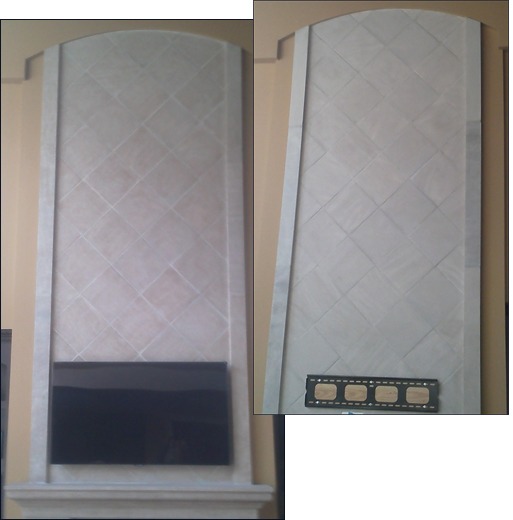
A Case Study
The Bressler family purchased a new home in Northern Indiana with the intention of completely remodeling the interior to create their “dream house.” They planned to make the living room especially appealing with new hardwood floors, a grand ceiling and a large fireplace. From a catalog, they chose to purchase an impressive limestone fireplace in a light tan/buff color that would fit in with the other renovations and with their choice of furniture.
The Wrong Color
After the limestone was installed, however, Mrs. Bressler noticed that it had a “splotchy” and “spotty” appearance, and that the color was more of a light grey than the tan/buff color she expected. The color did not match the rest of the expensive d??cor, and the irregular “blotchy” color added to the impression that it simply did not belong in the room.
She raised the issue with the manufacturer, who questioned her closely about the way the limestone had been stored and handled after being delivered to the home. When she admitted that her contractor had left the stone outside and uncovered for several days before installing it, the manufacturer took the position that the exposure to the elements must have caused a color change that might be temporary. The manufacturer then advised that the stone would return to its proper color after a sufficient length of time in the climate-controlled interior of the house.
When the hoped-for change did not happen spontaneously, Mrs. Bressler reviewed her options.
Options
She considered painting the stone, but did not want to compromise with her vision of a natural limestone fireplace. She understood that the painted stone would not “look real.” She also recognized that paint would run the risk of fading, peeling or cracking over time. One of the benefits of a real limestone fireplace is that the color remains constant without retouching or other maintenance.
After conferring with her contractor, she decided to have the entire structure sanded down from top to bottom. When this work was completed, some of the spotty irregularities in coloring were corrected, but the color remained an inappropriate grey. In her view, it was unsightly and did not complement anything else in the room.
Perhaps she could have insisted that the manufacturer and/or the contract bear the expense of removing the stonework and installing new limestone in the appropriate color, but:
- She did not want to damage her relationship with the contractor
- She believed that the manufacturer would not give her satisfaction unless she went to expense and trouble of legal proceedings
- She was unsure as to who was actually at fault in failing to provide her with the fireplace she paid for.
After further discussion, the manufacturer suggested that she try the process recommended in this paper: adding additional color into the surface of the stone using materials identical to those used by brick manufacturers.
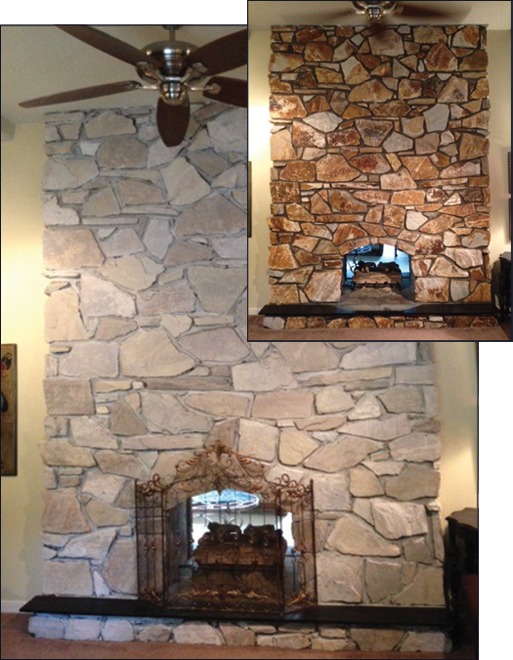
Adding Natural Color
With the manufacturer’s help, she located Masonry Cosmetics Inc., a company experienced in the staining process. After trading emails with the company’s VP, she sent him a sample of the limestone, so he could demonstrate the coloring technique. When he returned the stone, it looked exactly as she had hoped.
Pleased with the sample, Mrs. Bressler set up a date for the work to take place. The color specialist came, stained a small area, and asked Mrs. Bressler to approve the color.
After a few minor adjustments, the sample was approved and the main work commenced. The specialist applied the accepted color evenly across the whole fireplace and upper mantel, taking between four and five hours to complete the job.
Once the stain solution dried, Mrs. Bressler had the fireplace she had originally envisioned, in a custom color that she had helped create. It now blended in with the surrounding decor. No longer “an eyesore,” it was now a focal point of visual interest in the room. She had saved thousands of dollars and was given a lifetime warrantee assuring her that the fireplace would retain its color indefinitely without maintenance of any kind.
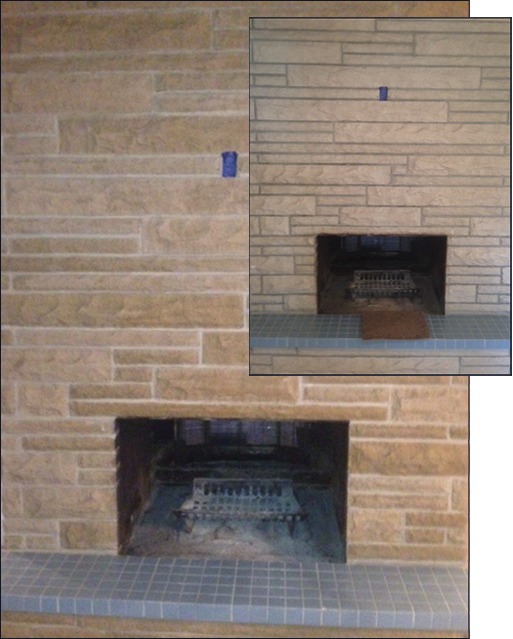
The Process
To create a natural-looking color change, colored pigments ground to the consistency of talcum powder are mixed with water and a bonding chemical. When the mixture is applied, the bonding chemical and the pigment are absorbed into the limestone. The bonding chemical hardens and locks the pigment to the pore structure of the stone.
The pigment is not smeared over the surface of the stone. Instead, it becomes part of the interior structure of the stone; its particles are locked in alongside the particles that gave the stone its original color. Therefore, the color change is gradual and the stone retains the color complexity of a natural product. The new color is no less a part of the stone than the original color. It will last as long as the masonry itself.
Do It Yourself
Rebuilding masonry is expensive. Hiring a professional to stain masonry is always much less expensive. Another even less-expensive option is for the homeowner to color the masonry. A homeowner can purchase a do-it-yourself kit that will contain everything needed to color an area much larger than the surface of any fireplace.
Masonry Cosmetics, the firm that colored Mrs. Bressler’s fireplace, offers a kit containing the pigments needed to closely match any desired color. The kit includes detailed step-by-step instructions and access to the firm’s training website. Customers are also entitled to ask specific questions and receive individualized guidance via email or phone.
| Advantages of Safe, Clean and Efficient Wood Heat |
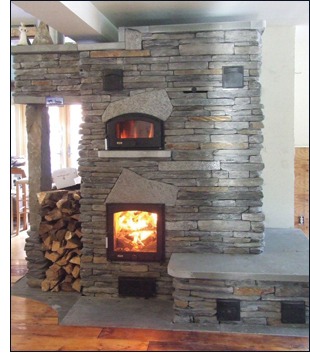 Residential wood-burning appliances need to be safe, clean and efficient, but also should be healthy. Masonry heaters, by the way they are designed, provide heat that is safe and healthy, and save money compared to other wood-burning devices.Masonry heaters are designed to burn fuel at its maximum efficiency. To properly burn wood, you need a flame temperature above 1,100 degrees Fahrenheit, a liberal air supply, and a good, dry fuel source such as split cordwood. Combustion temperatures this high burn up creosote in the firebox, preventing any buildup on flue walls. The heat produced by these high temperatures is stored in the masonry mass, and then gently and evenly released into a residence, business or office as radiant heat. A properly designed masonry heater can warm your home on one or two fires a day, eliminating the need for constant stoking. Residential wood-burning appliances need to be safe, clean and efficient, but also should be healthy. Masonry heaters, by the way they are designed, provide heat that is safe and healthy, and save money compared to other wood-burning devices.Masonry heaters are designed to burn fuel at its maximum efficiency. To properly burn wood, you need a flame temperature above 1,100 degrees Fahrenheit, a liberal air supply, and a good, dry fuel source such as split cordwood. Combustion temperatures this high burn up creosote in the firebox, preventing any buildup on flue walls. The heat produced by these high temperatures is stored in the masonry mass, and then gently and evenly released into a residence, business or office as radiant heat. A properly designed masonry heater can warm your home on one or two fires a day, eliminating the need for constant stoking.
Think of a masonry heater as a large warm rock in a home. It is a high-mass heat storage system. Short, hot fires generate tremendous amounts of heat, which is then stored in the masonry, to be slowly and evenly released into your home. Masonry heaters are true radiant heating systems, and there is very little temperature stratification in the home. Since radiant heat warms objects directly, you feel warmer over a wider range of air temperature. It’s like experiencing a sunny day and that feeling of well-being that your body intuitively recognizes. The design and size of the heater must be matched to our climate and your home’s heating requirements. Since the heat retention and output of the masonry heater are predictable, your heater builder can design a system that fits the homeowner’s needs. The Masonry Heater Association of North America is a non-profit organization dedicated to serving the interest of the masonry heating industry and its clients. Founded in 1987, MHA is an association of builders, manufacturers and retailers of masonry heaters. Visit www.mha-net.org for more information. |